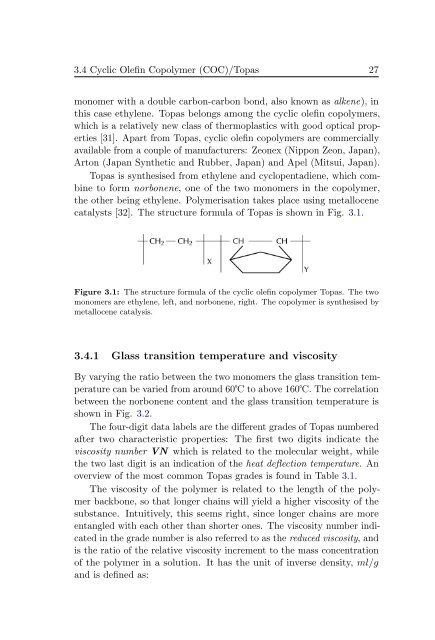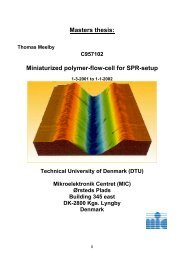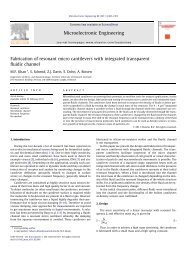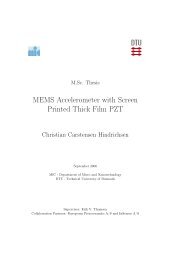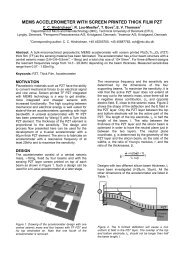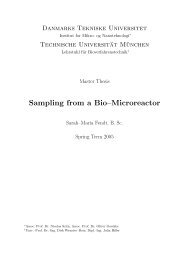Prototyping of microfluidic systems with integrated ... - DTU Nanotech
Prototyping of microfluidic systems with integrated ... - DTU Nanotech
Prototyping of microfluidic systems with integrated ... - DTU Nanotech
Create successful ePaper yourself
Turn your PDF publications into a flip-book with our unique Google optimized e-Paper software.
3.4 Cyclic Olefin Copolymer (COC)/Topas 27<br />
monomer <strong>with</strong> a double carbon-carbon bond, also known as alkene), in<br />
this case ethylene. Topas belongs among the cyclic olefin copolymers,<br />
which is a relatively new class <strong>of</strong> thermoplastics <strong>with</strong> good optical properties<br />
[31]. Apart from Topas, cyclic olefin copolymers are commercially<br />
available from a couple <strong>of</strong> manufacturers: Zeonex (Nippon Zeon, Japan),<br />
Arton (Japan Synthetic and Rubber, Japan) and Apel (Mitsui, Japan).<br />
Topas is synthesised from ethylene and cyclopentadiene, which combine<br />
to form norbonene, one <strong>of</strong> the two monomers in the copolymer,<br />
the other being ethylene. Polymerisation takes place using metallocene<br />
catalysts [32]. The structure formula <strong>of</strong> Topas is shown in Fig. 3.1.<br />
Figure 3.1: The structure formula <strong>of</strong> the cyclic olefin copolymer Topas. The two<br />
monomers are ethylene, left, and norbonene, right. The copolymer is synthesised by<br />
metallocene catalysis.<br />
3.4.1 Glass transition temperature and viscosity<br />
By varying the ratio between the two monomers the glass transition temperature<br />
can be varied from around 60℃ to above 160℃. The correlation<br />
between the norbonene content and the glass transition temperature is<br />
shown in Fig. 3.2.<br />
The four-digit data labels are the different grades <strong>of</strong> Topas numbered<br />
after two characteristic properties: The first two digits indicate the<br />
viscosity number VN which is related to the molecular weight, while<br />
the two last digit is an indication <strong>of</strong> the heat deflection temperature. An<br />
overview <strong>of</strong> the most common Topas grades is found in Table 3.1.<br />
The viscosity <strong>of</strong> the polymer is related to the length <strong>of</strong> the polymer<br />
backbone, so that longer chains will yield a higher viscosity <strong>of</strong> the<br />
substance. Intuitively, this seems right, since longer chains are more<br />
entangled <strong>with</strong> each other than shorter ones. The viscosity number indicated<br />
in the grade number is also referred to as the reduced viscosity, and<br />
is the ratio <strong>of</strong> the relative viscosity increment to the mass concentration<br />
<strong>of</strong> the polymer in a solution. It has the unit <strong>of</strong> inverse density, ml/g<br />
and is defined as:


